The Chuwi AeroBook Review: One Small Step For Chuwi
by Brett Howse on June 21, 2019 8:00 AM ESTGPU Performance
With just a 4.5-Watt Thermal Design Power for the entire SoC inside the Chuwi AeroBook, graphics demands are going to be a challenge, but if we compare the AeroBook to the previous Chuwi models, there’s still a substantial increase in raw performance available.
The Core m3-6Y30 features the Intel HD 515 graphics, which is several generations behind Intel’s latest, but the differences are minor since they’ve not really refreshed their GPU architecture for some time. The big difference between the HD 515 and the UHD 600 found in the latest Gemini Lake SoC Chuwi had leveraged before is that the HD 515 features 24 execution units compared to just 12 in the Celeron N4100. The HD 515 in the Core m3-6Y30 also has a higher Turbo frequency for the GPU – up to 850 MHz – compared to just 700 MHz on the N4100.
Still, as we’ve seen many times before, even with more TDP available, the integrated GPU on the Intel CPUs is really showing its age. To see how the Chuwi AeroBook performs, it was run through our Ultrabook GPU suite, which consists of a couple of synthetic tests, and one game which can be playable on an iGPU. We’ll see how the Chuwi performs though, and Chuwi’s decision to use single-channel RAM is likely to hurt the GPU scores the most.
3DMark

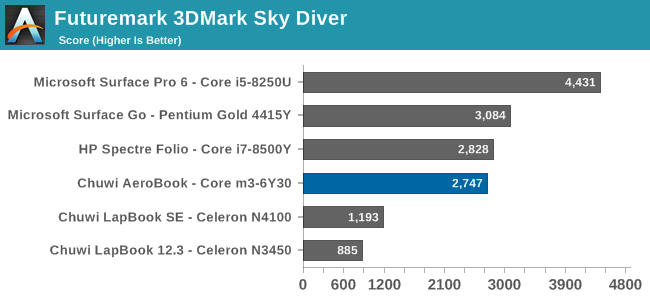
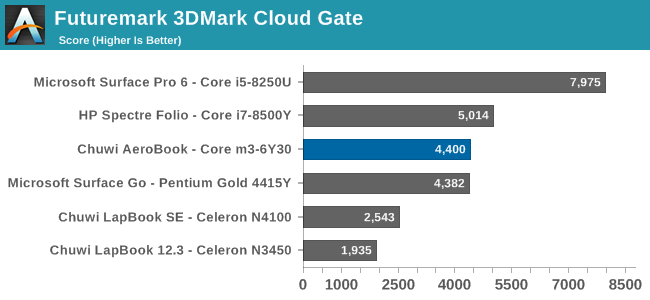
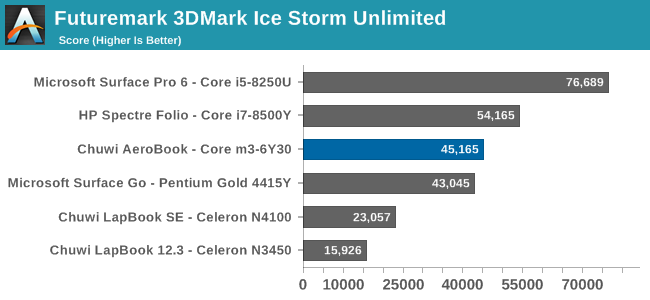
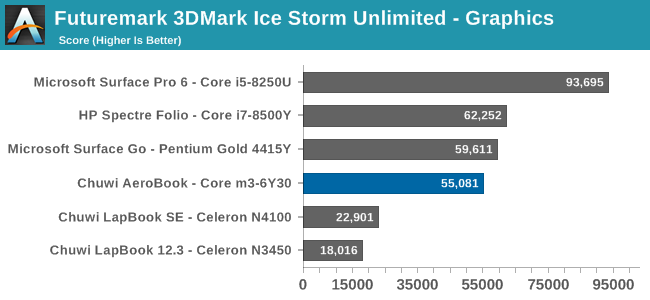

UL’s 3Dmark offers several tests of varying complexity, all the way from Ice Storm Unlimited which can be run on a smartphone, up to Fire Strike which can challenge even the latest GPUs. This test instantly shows the gap between the Atom powered Celerons and the Core powered devices, and even though none of these are powerful GPUs, even at a 5-Watt TDP the Core m3 offers double the performance of the Celeron.
GFXBench

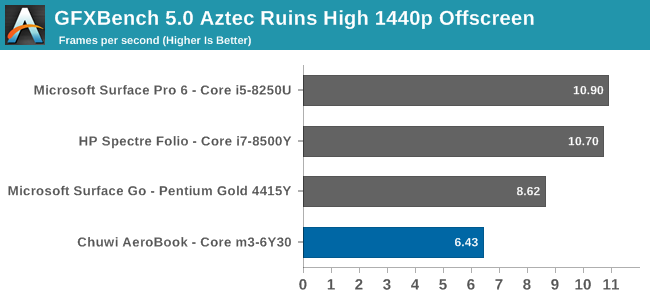
The latest Aztec Ruins test from Kishonti finally dumps OpenGL on the PC and offers DX12. Unfortunately the older Atom powered devices weren’t tested on this newer benchmark, but it does show the detriment that single-channel RAM plays since the Chuwi is the only device in the graph to not offer dual-channel memory.
Dota 2
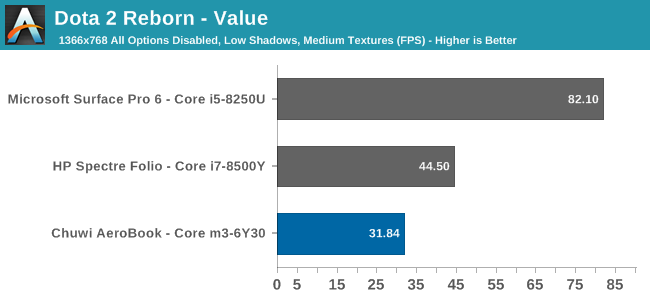
Valve’s Dota 2 continues to be our real-world game of choice for low-end devices because the game is one of the few that is actually playable even on an integrated GPU. Unfortunately the Chuwi is barely playable even at our lowest tested settings. The single-channel RAM is certainly a big factor, as is likely the lower CPU performance, since Dota 2 can be a CPU limited game as well.
GPU Summary
The move from Atom to Core brings with it a much larger GPU, and that improvement is clearly demonstrated in our results, but Chuwi’s decision to go with single-channel RAM definitely hurts overall performance. Intel’s integrated GPU really needs an update though, since even properly equipped and with a 15-Watt TDP like on the Surface Pro 6, it still struggles to offer much in the way of performance.
Storage Performance
Chuwi has also made a step up in storage. On most of their other low-end notebooks, they tend to offer eMMC storage, and although they generally offer more flash storage at the same price point as their competitors, eMMC doesn’t offer the performance of a SSD. The Chuwi AeroBook which is sold in North America comes with a single storage offering, and that is a 256 GB SSD, and in this case it’s a Netac model. Chuwi has offered a SSD before, but not as the boot drive, so this is a welcome change.
The performance is not fantastic, but still a step beyond what eMMC offers. The SSD is also accessible on the bottom of the notebook by removing two screws, so if you want to swap in a larger SATA SSD, it’s possible, which isn’t the case on most Ultrabooks without a lot of deconstruction.


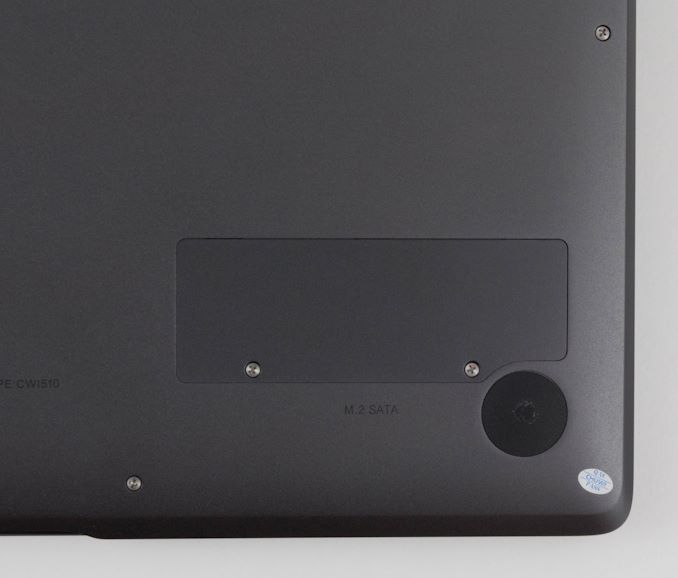
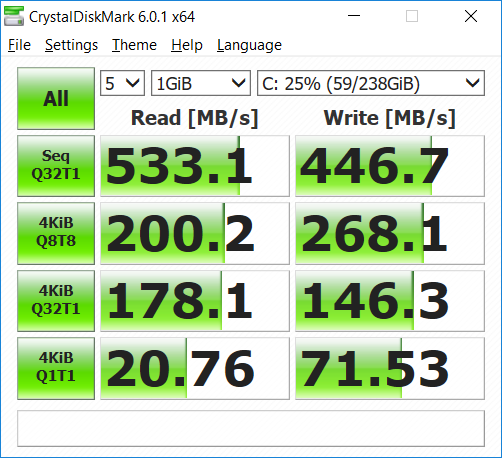








51 Comments
View All Comments
bubblyboo - Friday, June 21, 2019 - link
US-warranty vs no warranty is also pretty unfair.nandnandnand - Sunday, June 23, 2019 - link
Marlin and levizx are right. The sucker price is for suckers. There's something on sale in any given category at any moment. Go back a year or two and the main difference in a laptop will be the specific CPUs and GPUs, so judge price/perf accordingly.systemBuilder - Friday, July 19, 2019 - link
You can think of the "m" series of processors as "bringing the Atom Slowness to the Pentium Line of CPUs". In other words, when you spend 90% of your life thermally throttled because the device is stupid-thin AND stupid-light, you suffer a great deal... I prefer my Acer Chromebook c720 i3.Urthor - Saturday, June 22, 2019 - link
You have to understand the pressure that Intel puts on sellers with the prices of its CPUs to OEM'sSecondhand laptops have been FAR cheaper for a LOT longer because ultimately Intel's control of the key part stops them discounting.
mkozakewich - Friday, June 21, 2019 - link
Chuwi are a cheap manufacturer that have been known to ship cheap parts that fail, and they won't respond to warranty requests unless you can post a video to YouTube (seriously, what) showing some kind of physical damage.yeeeeman - Friday, June 21, 2019 - link
For 250$, maybe, but for 500...no wayabufrejoval - Friday, June 21, 2019 - link
I got the Lapbook 12.3 after the review here.The main attraction was the high-resolution (3k) screen and totally silent operation for e-books and surfing. And while my first unit had a defective space-bar and completely unusable touchpad (way too sensitive), the second one was rather better with both, and delivered on the performance and usability criteria.
I moved Windows 10 immediately to a 128GB M.2 SSD and then put a Ubuntu 18.04 on the eMMC, mostly because I needed a little more space anyway and to avoid slowing the machine via the storage.
The disappointment came when I unpacked the ChuWi in the hotel after a flight and found it all bent out of shape from a battery that had gassed out, because a replacement battery cannot be bought from anyone or anywhere: ChuWi simply does not sell spare parts.
It’s easy enough to replace, a couple of screws and unplugging a connector, but without a spare part, it’s life is essentially ended before a year is full.
After a bit of howling and screaming they did offer me to send it to HongKong for a free replacement, and I am torn between using it just on external power or actually see if it gets back fixed.
I’m not sure I can attribute the battery failure to a quality defect on their side, though.
It’s the second time the very same thing happened to me and the other one was a Gigabyte mobile workstation at 10x the price (no issue with the spare parts there).
I believe the fault actually lies with Windows.
When I hibernate a notebook, I expect it to stay powered off until I power it up again. But Windows these days has so much AI, it knows better and seems to wake up hibernated (not just suspended) machines for things like regular reports to Redmont.
Since some of my machines are configured to actually boot Ubuntu, CentOS or Fedora by default, that is especially useless, because the Windows induced wakeup has them boot an OS that didn’t even ask for that.
In the confines of rucksack in an overhead locker then, these machines can easily overheat and cook the batteries until they’re dead.
I have tried very hard to find a recipe to keep these wakeups from happening. I really do like the ability to keep documents and VMs open (and hibernated on SSD), while I travel.
So far the only way to avoid these wakeups, seems to be removing the power supply before hibernating the machines: At that point “hibernate” seems to be actually understood by Microsoft as meaning “don’t wake automagically so you don’t fry batteries by accident in an airplane”.
I have started using that approach on commutes, but for longer trips, I do shut down those laptops, because the risk of unwarranted wakeups is too high.
So there you have it: ChuWis don’t disappoint as hardware per se, but spare parts or service are not included at this price.
olafgarten - Friday, June 21, 2019 - link
Windows doesn't wake hibernated laptops unless some hardware connected to it issues a wakeup signal. You either accidentally hit the on button or you have a faulty keyboard wakeup key.Also if you are using Ubuntu as the main OS, you are probably booting into Grub and so Windows has no control over the wakeup.
abufrejoval - Friday, June 21, 2019 - link
And so would I have sworn, perhaps not on my life, but at least a case of beer...I was far more inclined to blame the flying or even the security scanners at the airport.
Yet major problems there would be hard to hide...
And then I got a Lenovo S730 ultrabook to replace it and observed it for days.
Hibernated it (hybrid disabled) and was very surprised to watch it power up and boot whatever happend to be configured as primary in the BIOS, ... and that changed between Windows 10 1903 and Fedora 30, depending on what was more frequently used.
Mind you, I disconnected all external devices, nothing and nobody touching it, the power button requires quite a bit of force to exercise, but within half an hour to a full one it would power on again.
Now, I am pretty sure, that nobody in my network sends magic packets or patterns, and in any case I disabled that too, but no change. There are dozens of jobs scheduled in Windows and I deleted quite a few of those, mostly the "calling home" type. Also stopped and disabled the "user experience service" etc.
But so far the only thing that changed the behavior was to change the unplugging and the hibernate sequence: With the power plugged in at hibernate, Windows seems to assume it's ok to run scheduled jobs. Without external power, "hibernate" is "hibernate".
And these days, when you say "shut down" on Windows, you have to uncheck a hidden option in Windows to actually *make* it shut-down. Otherwise it will be 'smart' enough to assume that restarting Windows more quickly is more important and interpret "shutdown" as suspend-with-fast-restart...
And I have seen similar behavior in desktops that were *suspended* to RAM, with all magic packets and PS/2 as well as USB events disabled in BIOS to cause power up.
On those systems, massive amounts of RAM and SATA SSDs made hibernation less attractive and standby seemed a good compromise...
Here on the Lenovo RAM is stuck as 16GB and the NVMe will restore RAM at 3GB/s...
But "wakeup2die" isn't really attractive.
Perhaps we could get a little more end-user data on this?
Mil0 - Sunday, June 23, 2019 - link
I've seen this behavior as well, using MSI/Acer laptops, so it's not limited to some manufacturers.Thanks for the no-power-when-hibernating trick, I'll use that from now on.
It's a bit silly that there is no thermal protection on the battery - should be a pretty easy/cheap fix.